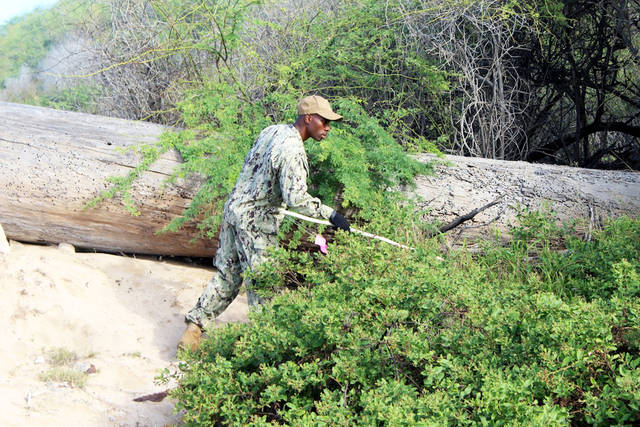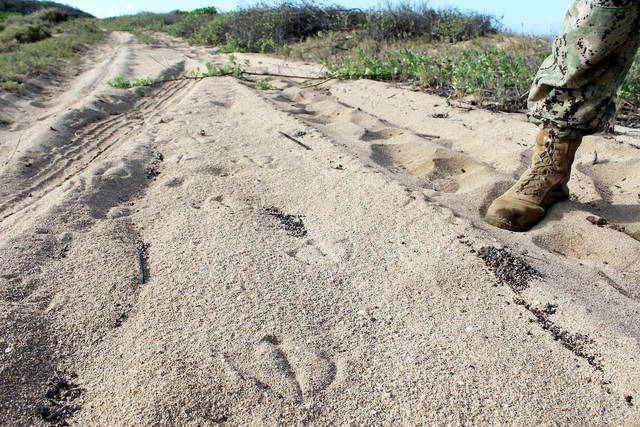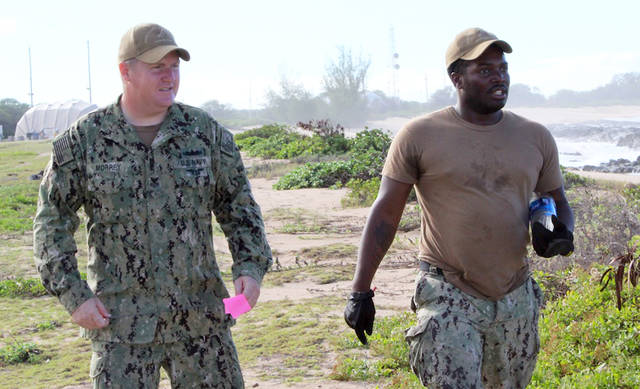Knee-deep in kiawe and spiders, about 15 sailors at the Pacific Missile Range Facility were on the hunt for albatross nests Wednesday morning, under the guidance of the base’s natural resource team and members of federal and state wildlife and land management agencies.
It was the annual “Easter Egg Hunt” at PMRF, where a translocation project is underway to move a Laysan albatross nesting colony to Kauai’s North Shore and refuges on Oahu and away from a busy runway.
It also helps increase the biological diversity of the albatross on Kauai, according to PMRF’s natural resources staff.
Split up into two teams, the volunteers on Wednesday searched in the nearly ever-present Westside sun in areas where albatross are known to nest. Experts put out flags to help aid in the search.
“I found a flag,” said Dente Jenkins from somewhere in a cluster of shrubs. He already had a handful of flags and ended up collecting six in total — the most in that group of egg-searchers.
There wasn’t an egg near the flag, though. There wasn’t even a nest. The flags were placed at known nesting sites and in areas where albatross could reasonably be located.
That was OK with PMRF’s natural resources manager, Rachel Herring, who reminded volunteers that while the nests and eggs are exciting to see, the point of the project is to lessen the number of nesting birds on the base.
That appears to be happening, but further study of data is needed to confirm what experts believe is a shrinking nesting colony in the area.
“We are working on a formal analysis, but pending that, preliminary information suggests the number of interactions our biologists are having with the birds may be slowly decreasing over the years,” Herring said.
In the past 15 years, the nesting colony has shrunk from about 80 recorded nests and, during the current 2019 season, PMRF natural resources workers and partners have recorded about 65 nests.
So far in the 2019 season, 67 eggs have been collected. Of those, 27 went to Oahu to contribute to the Laysan albatross population at Kaena Point State Park — 21 of the eggs were infertile, 16 were placed with foster parents on Kauai’s North Shore, and three are currently in PMRF incubators awaiting a space for translocation.
“They (the translocated birds and eggs) go to private property, and there are requirements for the area, like it being fenced against predators,” Herring said.
On Wednesday, volunteers from the second team of “Easter Egg” searchers found three adult birds, which were captured by the experts and relocated to the North Shore later that day.
While volunteers were searching, a few albatross flew overhead and skimmed nearshore waves. The only other bit of action the first group of sailors found were tracks in the sand showing albatross had, indeed, wandered through at some point.
Overall, the Laysan albatross population is on the increase, according to experts, but it’s more difficult to “tease out the current status” of the birds on the base.
“Many different factors come into play each season,” Herring said, “including life stage —proportion of breeders to non-breeders, seasonal variability in climate and ocean conditions —El Nino or La Nina effects and the level of effort and approach to management of the birds that season.”
Partners in the project include PMRF natural resources, Pacific Rim Conservation, Kauai Albatross Network, U.S. Fish and Wildlife Service and the state Department of Land and Natural Resources Division of Forestry and Wildlife.
•••
Jessica Else, environment reporter, can be reached at 245-0452 or jelse@thegardenisland.com.







The log next to the sailor appears to be at least 4 feet or thicker in diameter, much larger than native forest trees. So the question is whether its a drift wood or not?
So they want to lessen the number of eggs or birds on the PMRF base. What happened to preserve wildlife?